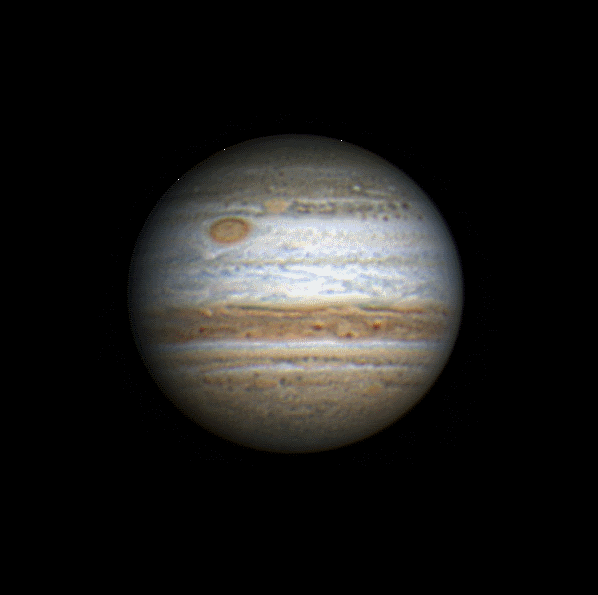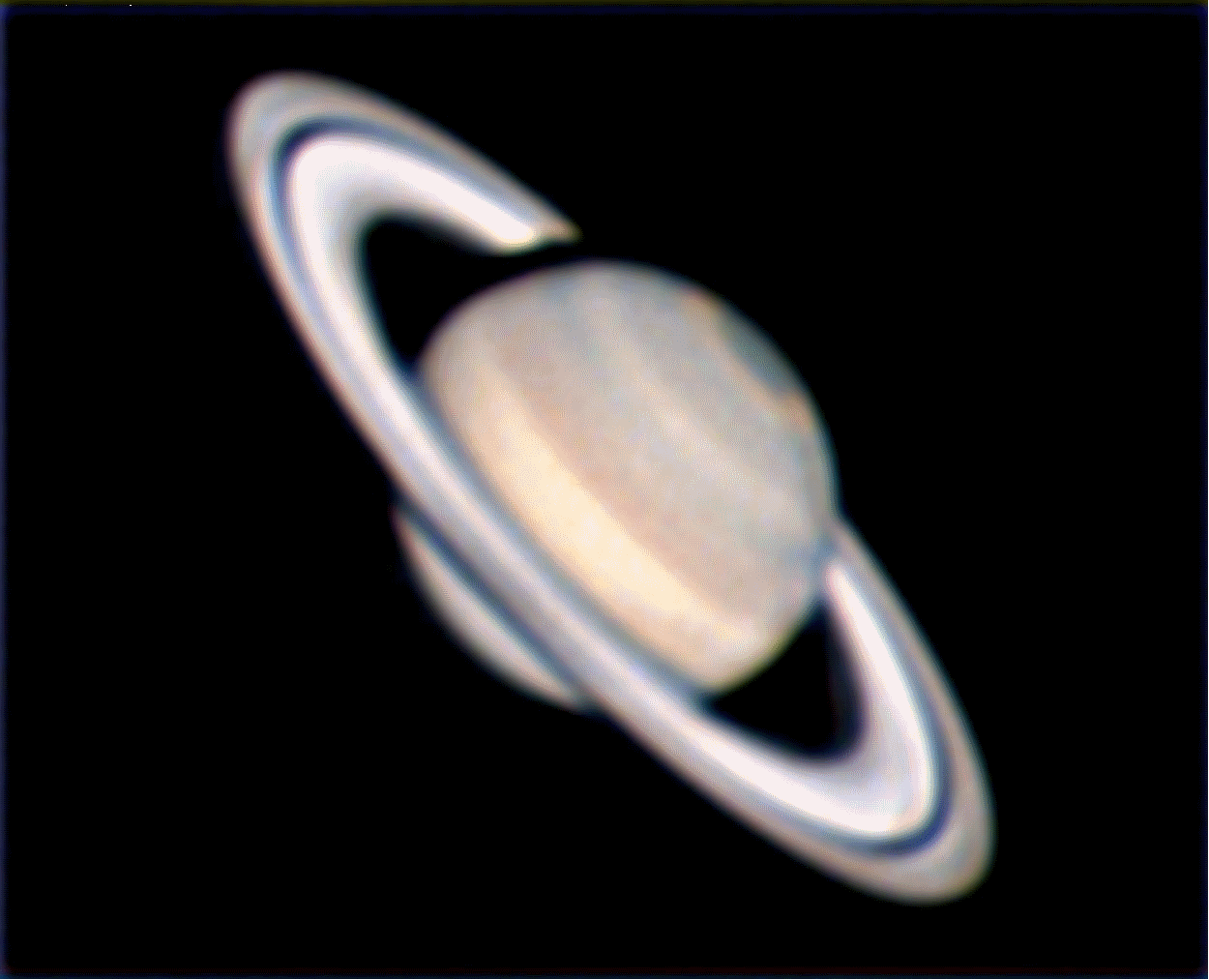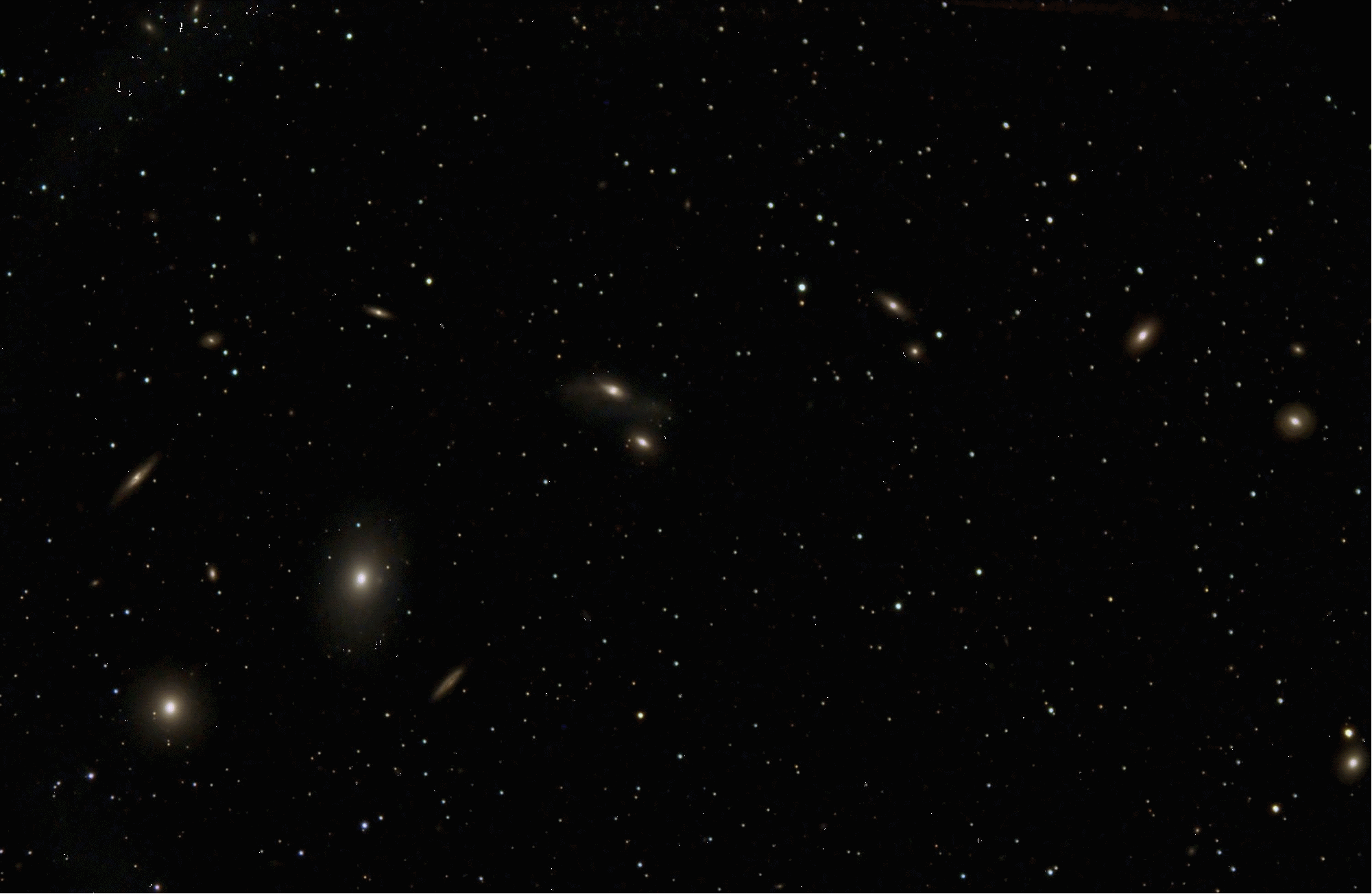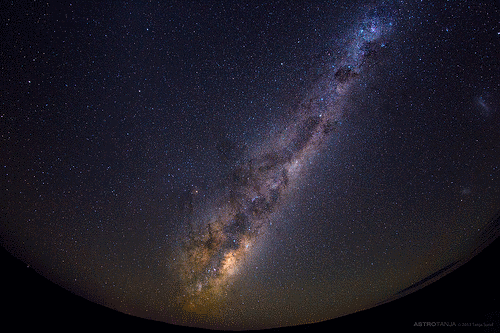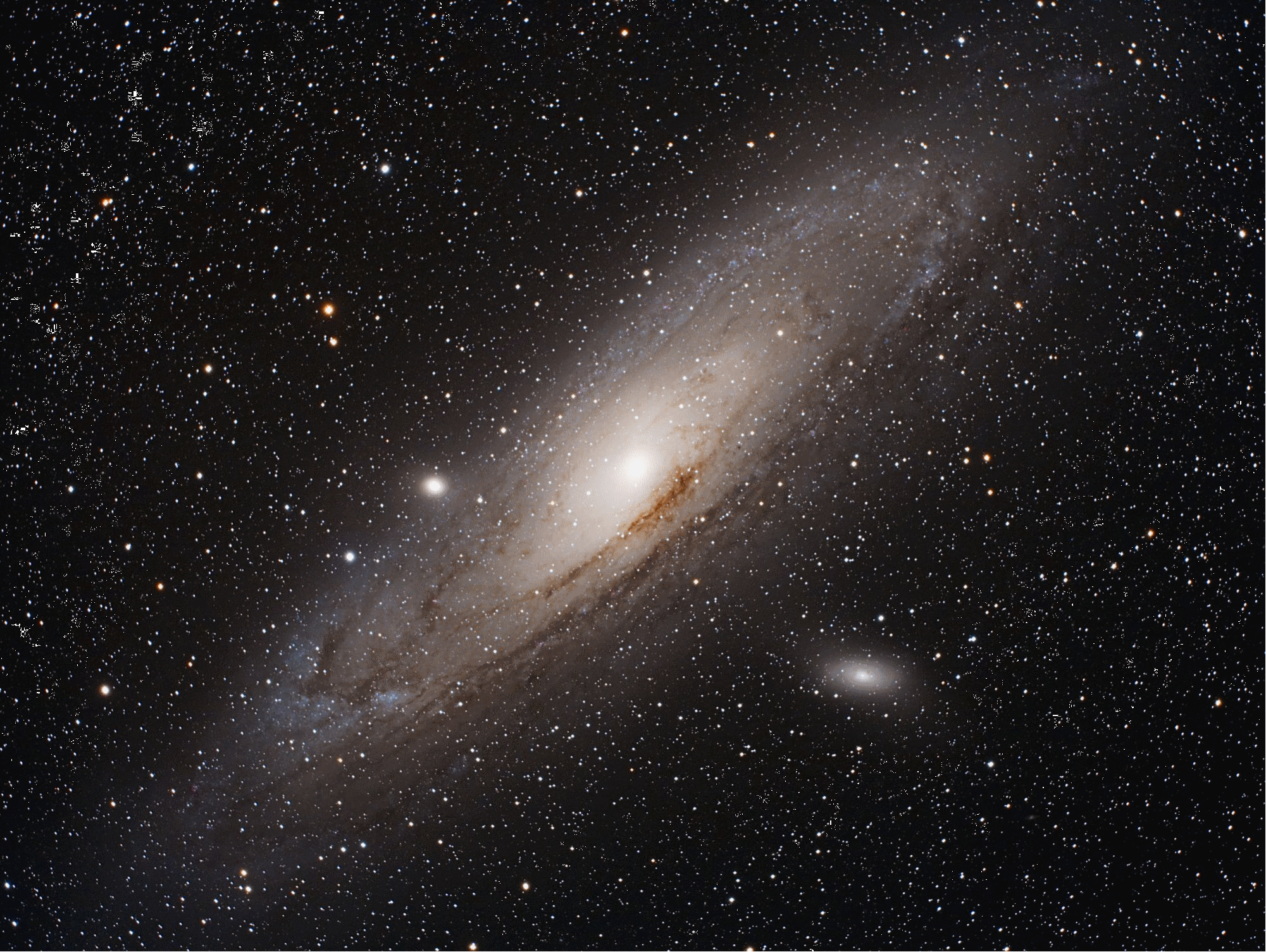
The year 2014 is filled with notable celestial events you won't want to miss. Mark them on your calendars and plan your star parties and observing nights around them.
Orion's 2014 Guide to the Sky begins with the most important dates to circle, followed by planetary and deep sky observing seasons, and finally, a detailed breakdown of sky events and Moon phases for each month. Follow Orion's Community on social media for up-to-date coverage on all of these events as the year unfolds.

Total Lunar Eclipse by Michael B. in Portland, Oregon, with Orion ED 80 80mm f/7.5 Apochromatic Refractor Telescope.
Most Important Dates to Circle in 2014:
March 20: Asteroid Occults Regulus - In the early morning hours, asteroid 163 Erigone has been predicted to obscure the bright star Regulus in Leo. Regulus will remain invisible for up to 12 seconds for those situated along the center of a 45-mile-wide path that extends from New York City to Oswego in New York and on up to Ontario, Canada. No telescopes or binoculars necessary to see the star flicker out.
April 14/15: Total Lunar Eclipse - Starting around 11p.m. on the night of April 14, watch the Earth's shadow cover the Moon in a total lunar eclipse. This is the first total lunar eclipse visible from North and South America in nearly 3.5 years. The Moon will be immersed in the Earth's shadow for 78 minutes, with a very good chance of turning a beautiful yet erie coppery red. On April 14, Mars will come within 57.4 million miles of Earth, the closest it's been since 2008. So while you're out watching the eclipse, make sure to train your telescopes on the fiery red planet, which will be as bright as Sirius! May 10: Astronomy Day - A human event, not an astronomical one, this is one of two days set aside to honor and celebrate the thrill of astronomy.
May 24: Meteor storm from Camelopardalis - Astronomers are forecasting that there may be a huge "storm" of meteors the night of May 24. If their predictions are correct, meteors may rip through the sky at a rate as high as 1000/hour! To best see this potentially historic event, plan to stay up most of the night and get away from city lights! Best views will be after the Moon has set. Stay tuned for updates on this potential spectacle, and plan on watching the skies for a day or two before and after, as these predictions may be a day or so off.
June 7: Moon & Mars Conjunction - The Moon and Mars will creep to within about two degrees (about 4 lunar diameters apart) on the night of June 7. Visible together from moonrise to moonset around 2 a.m. August 10: Supermoon - The Full Moon will come its closest to Earth all year on this date - 221,765 miles, making it the so-called "Supermoon" of 2014. Photographers, be sure to submit your images of the rising Supermoon to Orion's Facebook page. Those who live on the coast, expect a wide range in ocean tides, from extremely low to extremely high. August 12-13: Perseids Meteor Shower - The Perseids almost always delight, but unfortunately the Moon will interfere with the shower this year.
August 18: Venus and Jupiter Conjunction - The two planets will come within only ╝ degree from each other in the morning sky. M44 is only a degree away as well. This will be a spectacular conjunction to observe a few mornings in a row as the planets move closer to each other.
October 4: Astronomy Day - A human event, not an astronomical one, this is the second day of the year set aside to honor and embrace the love of astronomy. A wonderful night for public outreach!
October 8: Another Total Lunar Eclipse - Visible to the western half of North America, Hawaii, the Pacific ocean and as far east as the eastern half of Australia, the Moon will pass to the north of the center of Earth's shadow, with one hour of totality. Binoculars or a telescope will reveal a 6 magnitude greenish point of light near the Moon: the planet Uranus. For those viewing in northern Alaska and northern Canada, the moon will occult Uranus.
October 19th: Comet Flyby for Mars - Comet C/2013 A1 (Siding Spring) has a 1 in 8,000 chance of smashing into the surface of Mars, around 11:45 AM PDT. More than likely, it will come within 73,000 miles from the red planet, with a chance of its coma enveloping mars, and a spectacular shower of meteors as seen from the Martian surface.
October 23rd: Partial Solar Eclipse - A partial solar eclipse will be visible at sunrise in far eastern Russia, and most of North America before sunset. While the Moon's shadow will miss Earth, meaning there will be no totality, the Moon will be obscuring a rather large bite of the Sun just before sunset, at its greatest point of partiality. This eclipse begins at 19:37:30 UT, and ends at 23:51:36 UT.
Planetary Observing Seasons:
Jupiter - On Sunday, January 5, Jupiter is at opposition; directly opposite the sun in the sky. It will rise at sunset and be high enough above the eastern horizon 2-3 hours after sunset to do some serious observing and imaging. This is the "start" of the prime observing season for many amateurs that will run till April or early May. Jupiter is one of the best targets in the sky for monitoring detail and changes on a daily basis - so get out your high power eyepieces and eyepiece filters if you want to look and if you have a telescope with a motor drive (will track the stars or a planet) this is a fun first planetary target for beginning imagers.
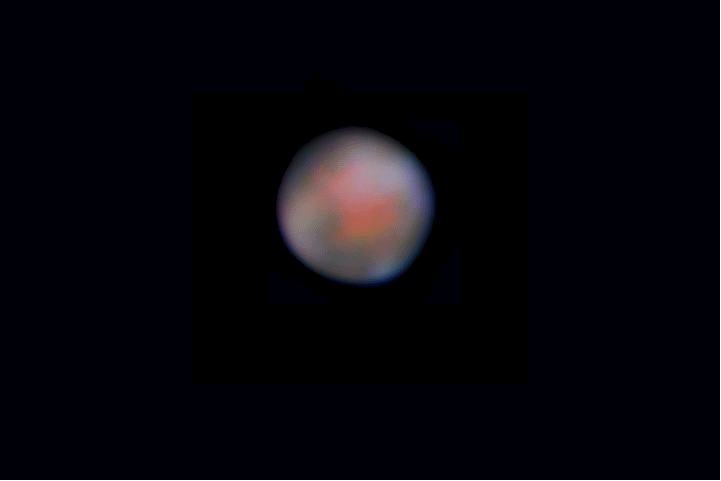
Mars, by Orion Staff.
Mars - Mars will be in opposition to the sun on April 8, showing a disk with an apparent diameter of 15 arc seconds (about half the size of Jupiter). Planetary cameras can capture usable information when the target is about 5 arc seconds in size or larger, so Mars is a definite target this year. The date of opposition (or close to it) is usually when a planet is its largest apparent diameter. So grab your equipment and grab a look at the Red Planet! Mars will be in a good position before this date if you what to stay up later in the evening; and in a good position to observe until about July.
Saturn - Saturn reaches opposition on May 10th. It will be in a good position to observe during the evening until about early September - basically most warm summer evenings! While Saturn is likely one of the most memorable sights in the sky, the planet's disk is not as detailed as Jupiter's (but the spectacular ring system makes up for that!). Like the other planets above, the bigger the telescope you have, the more likely you will have memorable views of the planets when the air is stable - but all of Orion's telescopes will show Saturn's rings.
Deep Sky Observing Seasons:
Galaxy Season - During spring evenings, the Earth faces away from the obscuring dust storms lurking in the Milky Way, and, luckily, it just so happens to face a few relatively nearby clusters of galaxies. So springtime, beginning in March, promises a load of interesting galaxies to explore, especially in the rich "Virgo Cluster of Galaxies."
From a dark sky site even Orion's StarBlast 62 can find dozens of springtime galaxies, but you'll probably want a 6-inch telescope or larger to really see the differences among the many galaxies you can capture in the springtime sky. And while low powers are great for sweeping up galaxies while star-hopping, don't be afraid to try medium or even high powers to see faint companion galaxies and to tease out some of the less obvious detail.
While there are wonderful galaxies to explore in nearly every constellation, they are concentrated in the triangle of the sky bound by Leo, in the west, Ursa Major in the North and Virgo to the southeast, the happy-hunting ground for galaxy enthusiasts. Galaxy season stretches for evening observers (as opposed to observers who get up after Midnight) from March through June.
Milky Way Season - Few sights in the nighttime sky can rival the spectacle of the Summer Milky Way from a dark sky location! When the Moon is absent and you are away from artificial light sources, the Milky Way will spread from the southern horizon arching overhead toward the north from July to October. Not only is our galactic arm a feast for the naked eye, its a treasure-filled delight to scan with binoculars or a wide-field ("Rich-field") telescope! The haze of the Milky Way is caused by the clumping of millions of individual stars, star clusters and gas and dust clouds.
The Jewels of Fall - Autumn brings crisp, clear nights and some of the brightest galaxies and star clusters in the sky, most notably: The Andromeda Galaxy (M31), the Pinwheel galaxy (M33), The Pleiades (M45) and the Double Cluster in Perseus. That's not all! Binocular and telescope users will find a veritable feast of telescopic targets that will delight the stargazer in everyone. The sparkling show jewels of in the fall sky is prominent during mid-evenings from October through January. The Season of the Hunter - Few sights are as dramatic as the path across the sky of one of the most recognizable constellations in the sky - Orion. But if you don't use optical aid you are missing the best part. Orion is chock full of amazing visual telescopic treats ranging from the Great Nebula in Orion to the planetary nebula NGC 2022. And to the east of Orion lurks the winter Milky Way: while far fainter than its summer version, it is rich in star clusters and emission nebulae.
Month-By-Month Sky Events of 2014:
January - Take advantage of the New Moon on January 1st and start the New Year with great views of galaxies, star clusters, and the winter Milky Way. Gigantic Jupiter will be a great planetary target for telescopes all month long, but the very best views of Jupiter will be during the evening of January 5th when the gas giant will be at opposition. Bundle up and keep your eyes peeled on the evening of January 2nd and into the early morning hours of January 3rd to catch the Quadrantids meteor shower! Look for meteors appearing to radiate from the constellation Bo÷tes. New Moons: 1/1 & 1/30. Full Moon: 1/16.
February - The second month of 2014 continues to offer great views of the winter Milky Way and will also feature a handful of interesting conjunctions to enjoy. On February 11th, the Moon and Jupiter will appear about 5░ away from one another, and on February 19th Mars will appear about 3.1░ away from the Moon. Late February features two especially close conjunctions: look for Saturn and the Moon to appear very close to one another on February 21st, and on the 26th, look for a close conjunction between the Moon and bright planet Venus. There is no New Moon in February. Full Moon: 2/14. That's amore!
March - Some of the best galaxies to see are spread across the night sky from Ursa Major to Virgo in March. Take advantage of the New Moon on March 1 and set sail for these island universes with a big telescope! Mars and the Moon will share the skies on March 18th during a conjunction. A couple days later you can enjoy a very close conjunction between the Moon and ringed Saturn on the evening of March 20th, which is also the March Equinox - the Sun will shine directly on the equator and there will be nearly equal amounts of day and night throughout the world. New Moons: 3/1 & 3/30. Full Moon: 3/16.
April - Get outside during the evening of April 14th/15th to enjoy a total lunar eclipse! The Earth's shadow will darken the nearly Full Moon from approximately 11pm on the night of April 14 until about 12:30 a.m. PST April 15 during this exciting event. Be sure to check out Mars for the best views of the year when it reaches opposition on April 8th. Don't miss the Lyrids meteor shower which peaks during April 22nd and 23rd. Scan the skies near the constellation Lyra after midnight on the 22nd for your best chance to see meteors. Full Moon: 4/15. New Moon: 4/29.
May - Grab a comfortable blanket or lounge chair and catch the Eta Aquarids meteor shower which peaks on the evening of May 5th. Meteors will appear to radiate from the constellation Aquarius. The best night of the year to observe Saturn and its spectacular rings is the evening of May 10th, when the planet reaches its closest point to Earth in its orbit. Four days later on May 14th, the Moon and Saturn treat us to a very close conjunction as they appear to pass within about a half degree of each other. Full Moon: 5/14. New Moon: 5/28.
June - Summer stargazing season kicks off in June with great opportunities to see a host of globular and open star clusters, emission nebulas, and more. Grab a pair of big binoculars or a wide-field telescope and scan the summer Milky Way for great views. The night of June 7th will see a conjunction between the Moon and Mars, and a few days later Saturn and the Moon will appear very close to one another for a pleasing sight in binoculars or unaided eyes. Full Moon: 6/13. New Moon: 6/27.
July - With constellation Hercules almost directly overhead and Scorpius to the south, there's plenty to explore in July skies as summer continues. On July 6th, grab a telescope or pair of big binoculars to see the Moon positioned close to Mars in the sky. Just a couple days later on July 8th, you can enjoy a close pairing in the sky between the Moon and Saturn. July winds down with the Delta Aquarids meteor shower. For the best chance to see meteors, get outside the night of July 28th and look towards the constellation Aquarius. The Delta Aquarids is an average shower that can produce up to 20 meteors per hour. It is produced by debris left behind by comets Marsden and Kracht. Full Moon: 7/12. New Moon: 7/26.
August - Use 50mm or larger binoculars and/or a telescope with a low-power eyepiece to explore the summer Milky Way in August for nice views of various star clusters, galaxies, and cloudy nebulas. Get outside after dark on August 13th to see meteors from the Perseids shower radiating from the constellation Perseus, but keep in mind that the bright Moon will make spotting meteors a bit of a challenge this year. On August 18th, Venus, Jupiter, and the Beehive Cluster form a conjunction in the sky for a spectacular sight. Neptune is at opposition on August 29. The blue giant planet will be at its closest approach to our planet, and its face will be fully illuminated by the Sun. This is the best time to view and photograph Neptune! Due to its extreme distance from Earth, it will only appear as a tiny blue dot in all but the most powerful telescopes. Closer to home, Saturn and the Moon treat us to another close conjunction on the night of August 28th. Full Moon: 8/10. (Closest Full Moon of 2014.) New Moon: 8/25.
September - The fall stargazing season begins with wonderfully placed spiral galaxies M31 (Andromeda Galaxy), M33 (Triangulum Galaxy), and M74 in Pisces. While binoculars and small telescopes can find these objects in a dark sky, use a big telescope to really "see" these glittering island universes. The September equinox occurs at 2:29 UTC on the 23rd. The Sun will shine directly on the equator and there will be nearly equal amounts of day and night throughout the world. This is also the first day of fall in the northern hemisphere, and spring in the southern hemisphere. Full Moon: 9/9. New Moon: 9/29.
October - Stargazers are in for a spooky treat during the early morning hours of October 8th when a total lunar eclipse darkens the Moon's surface; this eclipse will best be seen in the western U.S. and near sunrise on the East Coast. If you stay up late, you can enjoy nightly views of Jupiter in October and see its four brightest moons (Io, Ganymede, Europa and Callisto) change position each night. See the Orionids meteor shower on the night of October 21st as meteors appear to radiate from our namesake constellation Orion. Many locations will enjoy a partial solar eclipse on October 23rd. Full Moon: 10/8. New Moon: 10/23.
November - Bundle up for bright winter skies! See our namesake constellation Orion arch its way across the sky along with lots of bright star clusters. Get outside on the evening of November 18th to see the Leonids meteor shower as meteors appear to radiate from the constellation Leo. Full Moon: 11/6. New Moon: 11/22.
December - Don't miss the Geminids meteor shower which peaks on December 13th. Look for meteors to emanate from the constellation Gemini and the surrounding area. On December 19th, bundle up to check out a nice conjunction between Saturn and the Moon. The solstice occurs on the 21st at 23:03 UTC. The South Pole of the Earth will be tilted toward the Sun, which will have reached its southernmost position in the sky and will be directly over the Tropic of Capricorn at 23.44 degrees south latitude. This is the first day of winter in the northern hemisphere, and first day of summer in the southern hemisphere. Full Moon: 12/6. New Moon: 12/22.
Follow Orion on Facebook, Twitter & Google Plus, or check our Community page for up-to-date coverage on all of these events as the year unfolds.




